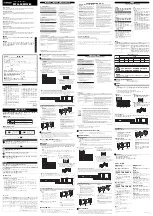
Series KSE/F, KSE-C/F
Page
10
9530-001-en
Revision 19
TM 9549
Edition 11/2018
6
Installation
The installation conditions to the AD 2000 Code
A2 (on pressure vessels) and TRD721 are to be
observed. They are major preconditions for the
safe operation of the valve.
♦
Examine valve for in-transit damage, damaged
safety valves must not be installed.
♦
Before installation the valve and the connecting
pipe must be carefully cleaned to remove any dirt,
especially hard foreign matter.
♦
During installation, pay attention to the correct
tightening torque, aligned pipes and tension-free
assembly.
6.1 Sizing of the outlet line
The admissible pressure loss in the inlet line
must not exceed 3% of the set pressure of
the safety valve.
The determination of the pressure loss relates to the
maximum flow of the valve at 110% of the set
pressure and 110% of the certified coefficient of
discharge.
♦
An excessive pressure loss at the inlet of the
safety valve can cause rapid opening and reseat-
ing of the valve or chattering.
♦
Chattering results in a reduction in the discharge
capacity and may cause an inadmissible rise in
pressure in the system and damage to the seat
sealing surfaces.
♦
The inlet line must never be smaller than the
nominal diameter of the safety valve inlet.
♦
Lay supply lines as short as possible.
♦
Install, if at all possible, the valve directly on the
container to be protected.
♦
At least chamfer the container nozzle in the inlet or
even better provide with a radius.
♦
An inlet nozzle with a tapered design has the best
shape in terms of flow.
6.2 Sizing of the outlet line
Outlet lines are to be sized so that reliable functioning
of the valve is ensured under all expected operating
conditions.
The medium is to be discharged so that there is no
risk to people and the environment. The statutory
provisions (e.g. accident prevention regulations, and
the equivalents of the German Pollution Control Act or
the German Clean Air Code) as well as local
regulations (works standards) are to be observed.
♦
There must be no possibility of the safety valves
becoming ineffective due to shut-off elements.
6.2.1 Admissible back pressure
♦
The outlet line must never be smaller than the
nominal diameter of the safety valve outlet.
♦
The admissible back pressure in the valve outlet
must not be exceeded in order to prevent destruc-
tion of the bellows or a reduction in the discharge
capacity.
Manufacturer's information on permissible back
pressures contains the safety valve test certificate or
the Richter publication "Component-tested chemical
safety valves, KSE series".
Detailed instructions for calculating the supply and
blow-off line are contained in the Richter publication
"Planning and implementing chemical safety valves".
This can be requested from Richter.
6.2.2 Drainage of condensate
Lay horizontal pipes with a gradient away from the
valve so that the liquid medium cannot accumulate in
the valve body and that, in the case of gases, no
condensate collects in the body.
If outlet lines are laid with a geodetic level difference
(e.g. for vapours or gases with a 90° vertical upright
pipe bend out of the valve), the bend must not be
located directly downstream of the valve.
A horizontal pipe section with a gradient must firstly
be installed downstream of the valve.
A draining facility must be provided at the lowest point
in the pipe. This opening for the drainage of conden-
sate must be lower than the flow chamber of the body.
Fig. 4
Lines for the drainage of condensate are to have
adequate cross sections. They are to be laid with a
gradient and must ensure safe drainage of the
medium.
Содержание KSE 100/150
Страница 24: ...Series KSE F KSE C F Page 24 9530 001 en Revision 19 TM 9549 Edition 11 2018 10 2 Sectional drawing KSE F...
Страница 28: ......
Страница 29: ......
Страница 30: ......











































